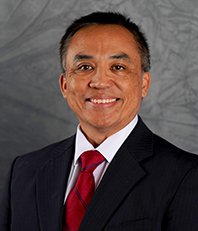Q&A: Dr. Romeo Ignacio

Rewarding and Rejuvenating: Dr. Romeo Ignacio's Surgical Missions
Giving back to the community is a natural instinct for many on our team, and international surgical missions are a meaningful and impactful way to serve. For this month's Q&A, we interview Romeo Ignacio, MD, of our Division of Pediatric Surgery. Dr. Ignacio discusses his recent surgical mission to Guatemala, as well as how hospitals abroad differ from those in the U.S. and what it takes to make the most of surgical service abroad.
Q: What was the purpose of your surgical mission in Guatemala?
A: Each year, a group of Navy surgeons, sponsored by Faith in Practice, travels to Antigua, Guatemala. Our team of nurses, surgical technicians, surgeons, pharmacists, and administrators work together to provide comprehensive orthopedic and general surgical care to children in need. It is truly a rewarding (and rejuvenating) experience for all of us.
Q: Did you have additional personal reasons for participating?
A: The personal reasons why I volunteer go back to the simple reasons why I became a doctor: To help those in need, to teach and train others (in resource-limited environments), and to make a difference in this world. I have also enjoyed the friendships of those I have worked with over the past few missions. Although we surgeons do this type of work every day here in the U.S., the experience of helping children and families in such resource-limited countries is a higher level of fulfillment and personal reward.
Q: What types of procedures were you charged with doing?
A: As a pediatric general surgeon, the cases widely vary from common procedures such as hernias, hydroceles, circumcisions, and orchiopexies, to more complex cases such as thyroglossal cysts, abdominal masses, congenital defects, and sometimes benign/malignant tumors. Over the years, we have improved the surgical capacity of cases in Antigua, and recently have been performing more head/neck cases and advanced laparoscopic cases (laparoscopic orchiopexies and hernia repairs in young children)
Q: Is there one particular patient who stands out in your memory, and if so, why?
A: One of my most rewarding cases was in the Philippines where a mother carved out a canoe (yes, out of a tree – not from Dick's Sporting Goods) and traveled across several miles of ocean. She then walked 80 miles on bare feet and pushed through a crowd of 3,000 patients in order to meet us on the USNS Mercy. Her severely malnourished, 2-year-old child weighed only 15 pounds. He had a large abdominal mass and a CT scan showed a rare abnormality called a fetus-in fetu. This is an extremely rare condition where a malformed fetus grows inside a twin. No local agency wanted to tackle this complex case. We performed the surgery on the USNS Mercy, and the child went home two weeks later. It shows what a mother is willing to go through for their child.
Q: How did your experience working in Guatemala differ from your experience working in hospitals in the U.S.?
A: Six years ago, the hospital in Antigua was run down and had basic surgical equipment (no pediatric or laparoscopic equipment). Many times, we did not have the desired instruments, sutures, or adequate room equipment to do several routine surgical procedures. Faith in Practice has provided missions in Guatemala for more than 20 years. Last year, we met President Alejandro Giammattei of Guatemala, who visited us and thanked us for our work in Antigua. Over the years, the donations and supplies have improved so much that many of the procedures performed in Antigua are similar to what is done in the U.S. What differs is the level of poverty that many of these children live in. Providing care to these patients and seeing the happiness of their parents is very moving.
Q: Have you participated in other surgical missions, and if so, where/doing what?
A: Before retiring from the U.S. Navy, I was involved in various Southeast Asia, Southern American, and Central American humanitarian missions. Some of those missions involved the USNS Mercy which is a 1000-bed hospital ship that you may have seen in San Diego. Those amazing experiences inspired me to continue such volunteer work in Guatemala. I also am on the board of Corporal Works of Mercy which is my church's group that oversees missions in the Philippines, Mexico, Sudan, and Haiti. This past summer, I returned from the Philippines in hopes of setting up a pediatric surgical mission there in the future.
Q: Why is it important for U.S.-based surgeons to do surgical missions abroad?
A: First, I do not think surgical missions abroad are meant for everyone. There are a great deal of sacrifices and obstacles in operating in a low- or middle-income country with limited resources. It is also challenging to find time away from work as well as your family. I personally like the challenge and believe the reward of helping out others and such poverty-stricken areas is worth it.
